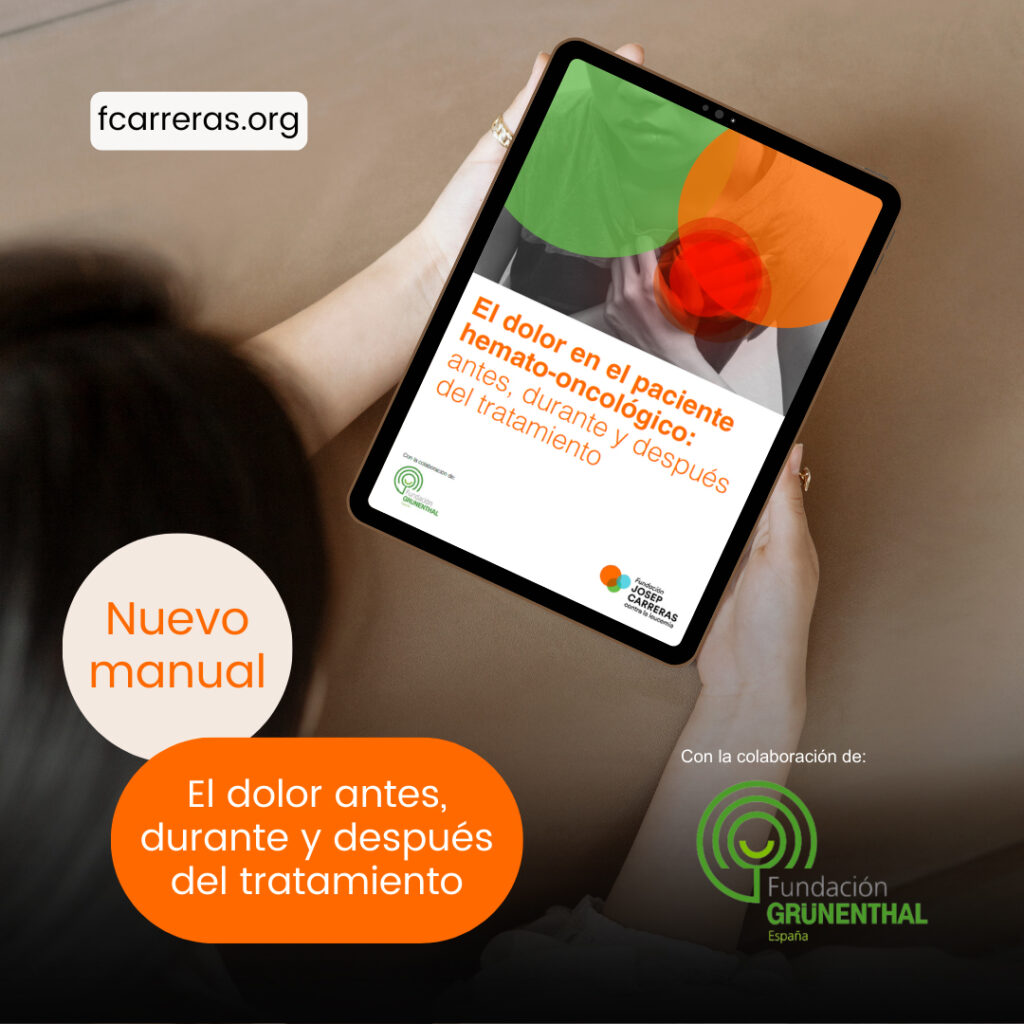El 90% de los pacientes con cáncer sufre dolor, según la Sociedad Española de Oncología Médica (SEOM).
Las particularidades de las enfermedades hematológicas, como las leucemias, implican que los pacientes y sus médicos enfrentan desafíos distintos a los asociados con tumores sólidos.
A nivel psicológico, los pacientes experimentan una disminución de su capacidad funcional, así como la aparición de síntomas físicos y emocionales que alteran sustancialmente su calidad de vida.
La Fundación Josep Carreras contra la Leucemia, con la colaboración de la Fundación Grünenthal, publica la Guía ‘El dolor en el paciente hemato-oncológico: antes, durante y después del tratamiento’. Este documento proporciona recomendaciones para manejar el dolor asociado a las enfermedades hematológicas en sus diferentes etapas del tratamiento, así como a nivel emocional por el impacto psicológico y funcional que tiene en los pacientes.
Las particularidades de las enfermedades hematológicas, como las leucemias, linfomas o el mieloma múltiple, entre otros, implican que los pacientes y sus médicos enfrentan desafíos distintos a los asociados con tumores sólidos, aunque estos últimos también pueden presentarse en algunos casos de enfermedades hematológicas, como los linfomas. El documento ofrece una hoja de ruta clara para abordar el dolor que acompaña a estas enfermedades, enfatizando la necesidad de un enfoque diferenciado y especializado.
La Guía, que alude también a un estudio de Grünenthal que incluyó a 49 pacientes en España (549 en total a nivel europeo) con Dolor Neuropático Oncológico (DNO) sobre cómo afecta este tipo de dolor en su vida, revela que en Europa se registran 2,7 millones de nuevos casos anuales. El documento evidencia que 1 de cada 5 pacientes presenta dolor intenso a diario, el 47% ha tenido que faltar al trabajo o a clases y el 12% ha abandonado su profesión debido al dolor. Además, a nivel emocional, el 37% manifiesta que le ha afectado a la autoestima.
Ante estos datos, el documento incide en que muchos de los dolores que puede experimentar un paciente son manejables, por lo que controlarlos y mejorar la calidad de vida son un objetivo fundamental del tratamiento. La publicación resalta que además de los medicamentos, una alimentación adecuada y equilibrada junto con ejercicio físico, pueden aliviar algunos dolores, además de la gestión del miedo e incertidumbre que debería cubrirse siempre con apoyo emocional especializado. Por ello, la Guía insta a los pacientes a que acudan a su médico para que les derive al nutricionista y al fisioterapeuta y evalúen qué tipo de dieta y ejercicio pueden ser apropiados para mejorar su situación.
Por último, la publicación hace hincapié en la importancia de realizar ejercicio físico durante el transcurso del tratamiento oncológico, ya que la densidad ósea puede disminuir, dando lugar a la osteoporosis, cuyas principales causas son los tratamientos médicos y el prolongado período de inmovilidad. Una reducción significativa en la densidad ósea puede comprometer la integridad estructural del hueso, especialmente si se pierde la estabilidad, por lo que ante indicios de osteoporosis se debe incrementar la actividad física. El deterioro de los huesos por las llamadas lesiones líticas es especialmente significativo en los pacientes de mieloma múltiple.
Alexandra Carpentier, responsable de Experiencia del Paciente de la Fundación Josep Carreras contra la Leucemia, incide en “la importancia de informar al hematólogo sobre el dolor ya que muchas veces el paciente asume que el dolor constituye una parte “normal” del cáncer. Es muy importante tratar el dolor en cuanto aparece o impedirlo antes de que comience a hacer estragos. Una vez que el dolor se intensifica, puede ser más complicado de tratar. Además, muchos de los dolores que puede experimentar un paciente son manejables y controlar estos dolores y mejorar la calidad de vida de los pacientes son un objetivo fundamental del tratamiento”.
¡Gracias a la Fundación Grünenthal por apadrinar este manual! También agradecemos la colaboración de Alex Montesinos, fisioterapeuta oncológico (@oncotherapybcn) y Raquel Sánchez, dietista integrativa especializada en oncología (@ahora_que_como)!








